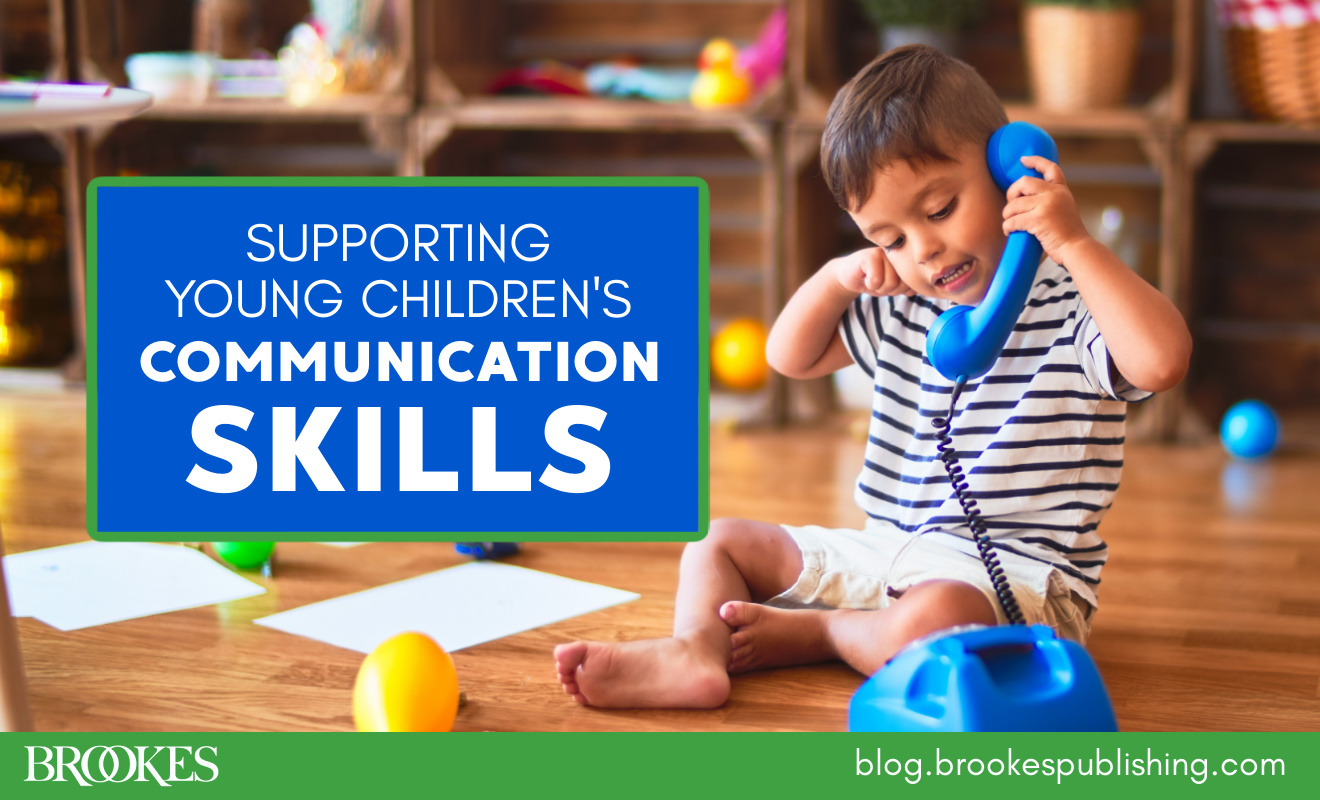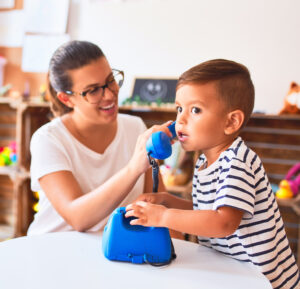10 Easy Ways to Support a Young Child’s Communication Skills
January 11, 2024
Help lay a foundation for young children’s communication and language skills with the activities and suggestions in today’s post! Adapted from six of our resources on early intervention and development (see the end for credits), this is a great collection of tips for professionals to use and share with families as they nurture their young child’s early communication and promote development of new language skills.
 Support communication through storytelling. Encourage children to begin to make up stories of their own. Write them on a piece of paper as children tell them to you. They might like to draw or paint a picture to go along with the story. You can put these stories in a folder to make a book titled “My Own Stories.”
Support communication through storytelling. Encourage children to begin to make up stories of their own. Write them on a piece of paper as children tell them to you. They might like to draw or paint a picture to go along with the story. You can put these stories in a folder to make a book titled “My Own Stories.”
Listen together—then talk! Turn off the television and other electronics, and listen with children to sounds around the home or classroom. Listen to the refrigerator motor, wind chimes, a clock ticking, or people talking. Ask children to tell you what they hear.
 Spark conversation with a photo album. Make a little album with pictures of the child and the people and pets they know. Have the child talk about the pictures and name the people and pets. Ask the child, “Who’s that? What are they doing?” Look at this book over and over. Help the child learn to say their first and last name.
Spark conversation with a photo album. Make a little album with pictures of the child and the people and pets they know. Have the child talk about the pictures and name the people and pets. Ask the child, “Who’s that? What are they doing?” Look at this book over and over. Help the child learn to say their first and last name.
Put on a play. Have kids collaborate on a short play using a few puppets. They can adapt a familiar story or fairy tale, or create their own story together. After they put on the play, talk with them about the story and characters, and ask them questions about how they developed the play.
Set up some sensory activities. Sensory activities, in which kids explore the environment around them through their senses, offer a great opportunity to promote social-communication skills. Describe materials and processes verbally during sensory play using parallel talk: describe what you’re doing, what the child is doing, and how materials feel to you. Talk with children about topics or items that interest them.
 Cook—and chat—together. Help children choose and combine ingredients for fruit salads, healthy sandwiches, omelets, and pasta dishes. Make snacks and lunches special by involving the child and their friends in decorating individual portions or platters using raisins, cereal pieces, slices of cheese, fruits or vegetables, and herbs to create pictures and designs. Read books about food and talk about where different foods come from, how they are grown, and the people who grow and harvest them. Make your own recipes and recipe books.
Cook—and chat—together. Help children choose and combine ingredients for fruit salads, healthy sandwiches, omelets, and pasta dishes. Make snacks and lunches special by involving the child and their friends in decorating individual portions or platters using raisins, cereal pieces, slices of cheese, fruits or vegetables, and herbs to create pictures and designs. Read books about food and talk about where different foods come from, how they are grown, and the people who grow and harvest them. Make your own recipes and recipe books.
Join kids in fun role plays. Kids love taking on new and different roles—and it’s the perfect opportunity to help them expand their developing communication skills. As you engage in everyday activities in the classroom or at home, join them in pretending to be favorite characters from storybooks or TV shows. Encourage children to express the distinct perspectives of their characters; for example, Cookie Monster might want to eat everything in sight, and Goldilocks might forget her manners and need to be reminded. Prompt children to talk with your imaginary and puppet friends, just as you talk with theirs.
 Use lots of action words. To expand the number of verbs in a child’s vocabulary, tell the child what you’re doing throughout the day using a variety of action words (e.g., “I am brushing my hair. Would you like to brush your hair?”). Play games using action words by asking the child to jump, run, reach, climb, and roll. When reading to a child, discuss the action of the characters in the book and invite the child to repeat the verbs after you. Ask them to find the character that is carrying out different actions.
Use lots of action words. To expand the number of verbs in a child’s vocabulary, tell the child what you’re doing throughout the day using a variety of action words (e.g., “I am brushing my hair. Would you like to brush your hair?”). Play games using action words by asking the child to jump, run, reach, climb, and roll. When reading to a child, discuss the action of the characters in the book and invite the child to repeat the verbs after you. Ask them to find the character that is carrying out different actions.
Make objects visible but unreachable. Placing objects within a child’s sight but out of reach is often an effective strategy to use with children learning early communication skills. For example, placing foods in the center of the table before serving them allows you to name the items and wait for children to request them. (When using this strategy, make sure the child is in no danger in their pursuit of the out-of-reach object!)
 Engage in responsive conversations. As you talk during routines and activities, remember that children’s language skills are enriched and expanded when adults engage them in back-and-forth conversations that extend over multiple turns and encourage the child to play an active role. Asking kids to tell personal narratives about their experiences is a good way to initiate these responsive conversations. Dickinson & Morse use the phrase “strive for five” as a rule of thumb: try to have a sequence of five back-and-forth exchanges with the child before the conversation ends.
Engage in responsive conversations. As you talk during routines and activities, remember that children’s language skills are enriched and expanded when adults engage them in back-and-forth conversations that extend over multiple turns and encourage the child to play an active role. Asking kids to tell personal narratives about their experiences is a good way to initiate these responsive conversations. Dickinson & Morse use the phrase “strive for five” as a rule of thumb: try to have a sequence of five back-and-forth exchanges with the child before the conversation ends.
What’s your favorite thing to do with young children to help their communication skills flourish? Share what works for you in the comments below—and for many more tips on promoting early communication and language skills, check out the books behind today’s post!
- Tips 1-4 adapted from ASQ®-3 Learning Activities by Elizabeth Twombly and Ginger Fink
- Tip 5 adapted from AEPS®-3 Curriculum: Ready (Volume 5) by D. Bricker, C. Dionne, J. Grisham, J. J. Johnson, M. Macy, K. Slentz, & M. Waddell
- Tips 6-7 adapted from Talk to Me, Baby!, by Betty Bardige
- Tip 8 adapted from Early Intervention Every Day! by Merle J. Crawford & Barbara Weber
- Tip 9 adapted from An Activity-Based Approach to Early Intervention by JoAnn Johnson, Naomi L. Rahn, and Diane Bricker
- Tip 10 adapted from Connecting Through Talk by David K. Dickinson & Ann B. Morse




Write a Comment
Your email address will not be published. Required fields are marked *
Post a Comment